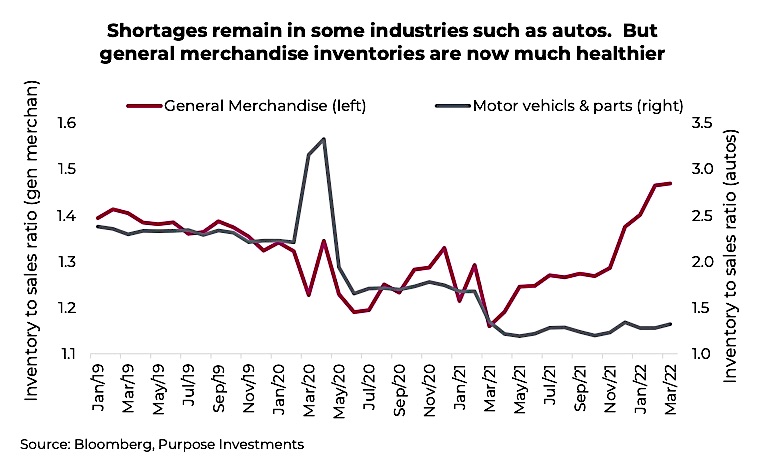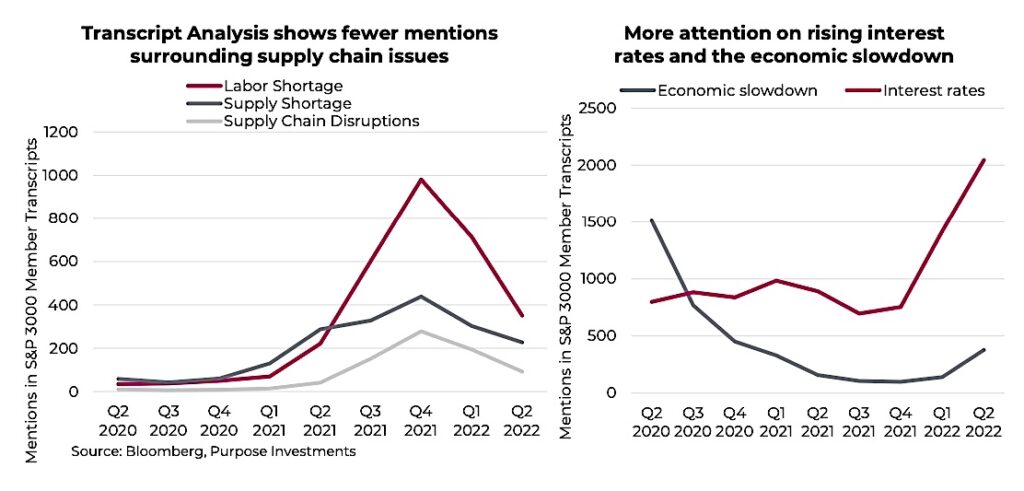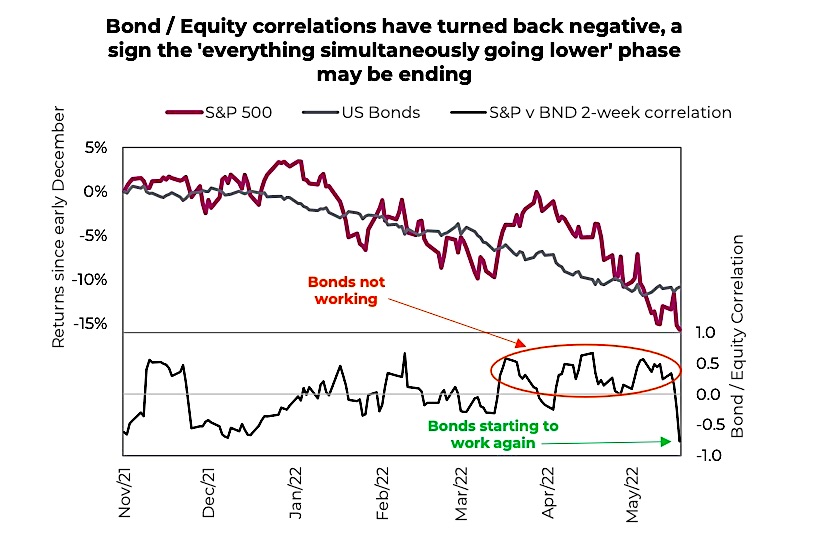As you probably notice in financial media and in your real life, everyone is talking about inflation. This should not be viewed as the wisdom of the crowd as once an economic topic reaches the masses, it is often priced into the market and potentially about to start reversing. Could we be at that stage now? After all, the easiest cure for inflation, outside peace in Ukraine, is slower economic activity. And that is happening.
There is no denying the global economy is starting to slow. Rate hikes, tightening financial conditions, a strong U.S. dollar, higher energy prices, … the list goes on. This was widely expected in its effect, but perhaps not its timing. Over the past few weeks, the fear from the market’s perspective has clearly shifted from inflation/yields/Fed to the global economy. But this market is manic in how it reacts to news, perhaps because of the preponderance of bad news so far in 2022.
Some good news – inflation fears starting to fade. We talked about “Peak Hawkishness” five weeks ago and can report that expectations for 2022 Fed Funds and Bank of Canada rate hikes have turned over and declined since then.
Price adjustments are slow-moving processes in the economy. An economy that we froze and then thawed, rather abruptly, caused many dislocations. And while inflationary pressures are not ending as some of these dislocations persist, many of the previous forces are abating. Take copper prices – they had been rising for most months this year and have now fallen 12% over the past month. Importantly, they are lower year-over-year as well, which is predominantly how inflation is measured. The same is also true of lumber as shortages are also easing.

Much of the inflation was caused by imbalances after consumption patterns changed drastically. The supply side was caught off guard and unable to respond to stronger-than-anticipated resumption of demand. Shortages and a low inventory-to-sales ratio fueled inflation. Now the ratio is better; supply is catching up as demand is starting to slow for general merchandise and shift back to services. This trend is evident in other categories as well, from home furnishings to building supplies. Autos remain the outlier now as supply continues to struggle.
This improving trend is also evident during company earnings calls. Among the 90% of Russell 3000 companies that have reported, mentions of labour shortages, supply shortages, and supply chain disruptions has fallen this quarter. On the rise however, are interest rates and economic slowdown, which is a concern.

Inflation isn’t gone, but the upward direction is slowing. Yes, China lockdowns remain a risk for inflation, furthering hampering supply chains, but the system appears to be getting more resilient. Also worth noting, household durables and apparel have a high China content — these two categories have seen some of the biggest slowing of demand, which diminishes the China-effect.
While we hear and read a lot about stagflation, it takes a special set of circumstances to have both slowing growth and rising inflation. It is certainly a risk, but we feel as growth slows, inflationary pressures should ease in the coming months. The bond market has already sniffed this out. Ten-year U.S. and Canadian yields, which both reached 3.12% have retreated to below 2.90%. 5-year forward breakevens, a measure of how much inflation is priced into the bond market, have been falling over the past month after rising significantly in March. Add all this up, and the market is becoming less concerned about inflation. This is good news and has helped bonds once again start to behave in a way that benefits our portfolios. That is, during periods of equity weakness, bonds have started to rise in price, providing a stabilizer. This is welcome relief compared with the previous months that saw both equities and bonds falling together.
The following chart shows the performance of the S&P 500 and U.S. bonds since the beginning of December. Bonds and stocks falling together has made 2022 particularly painful. This can be seen in the lower part of the chart, showing the two-week rolling correlation between equities and bonds. This was around zero or even positive for the past few months. Until recently, as the equity correction accelerated to the downside, a more normal relationship between bonds and equities resumed. Equity markets moving lower is never good, but bonds behaving more as a stabilizer is encouraging, indicating that the inflationary price resetting may be nearing an end.

Less inflation is good news for markets but exchanging that news for rising recession risk is bittersweet. Admittedly, we did consider, “Out of the Inflationary Frying Pan and into the Recessionary Fire” as the title for this week’s Ethos. But it’s way too early to combine the word “recession” and “fire.” Yes, the probabilities of a recession have risen but it still is not our base case for 2022. We went down this road last week and will likely keep revisiting this theme in future publications. The cycle is not dead, so there is a recession out there somewhere. We remain vigilant.
Investment implications
The cure for inflation has always been slower aggregate demand. Less spending lowers profits, lower profits spurn layoffs, and so the cycle goes. That slower demand is starting to materialize. This has already begun relieving inflation fears within the bond market, which likely has a better gauge on the situation than folks talking on the bus or the random interviewee on the news. This could open the door for a broader bounce, assuming the slowing growth talk doesn’t become too loud. Asset price correction (that is where we are now), market reprieve (bounce), and then another correction caused by slowing growth have remained our most likely path for markets this year. Of course, we say this with the cautionary note that markets typically surprise everyone in one direction or another.
As tough as they have been, looking to bonds as a relief valve in a portfolio is a benefit, and the risk/reward looks far more attractive than even a few months ago. Even for the conservative investor, high quality short corporate bonds actually have some yield again!
Source: Charts are sourced to Bloomberg L.P., Purpose Investments Inc., and Richardson Wealth unless otherwise noted.
Twitter: @ConnectedWealth
Any opinions expressed herein are solely those of the authors, and do not in any way represent the views or opinions of any other person or entity.







